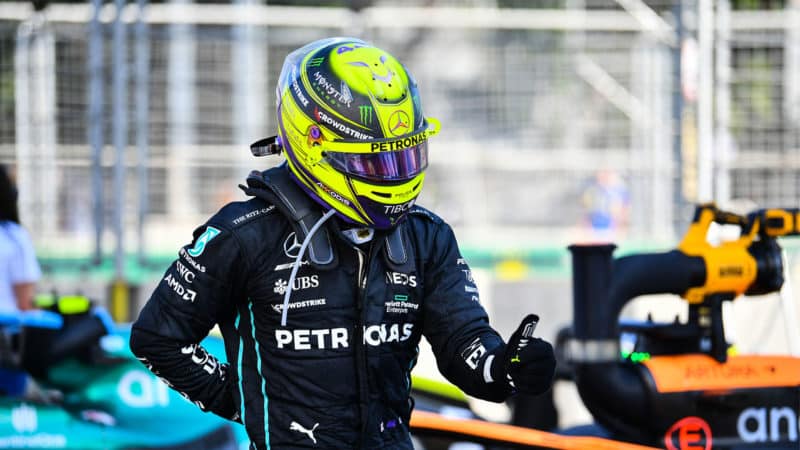Backing this up, Russell added, “In Baku, I could see my pit board but I couldn’t read it because I was bouncing around so much. I saw a video of Lance [Stroll] struggling to change the buttons on the steering wheel and you could visibly see how much the car was shaken around.
“Even for the teams suffering the least, it’s still an incredibly aggressive and bumpy ride. The FIA have access to all the vertical acceleration loads we’re going through, and it’s far beyond what you’d expect is safe to deal with. Bigger conversations are definitely needed moving forward.”
Then, predictably enough, a different view from Ferrari’s Charles Leclerc: “I don’t completely agree. I feel like it’s the team’s responsibility to give me a car that’s okay to drive. Until now, I didn’t have any particular problems. Yes, it’s stiffer than last year’s car. Whether it’s undriveable or very hard on myself…I don’t think it is. We found solutions to make it better.”
It has been claimed that if Mercedes is having more serious issues, they simply need to run their car higher, at the cost of some performance.
Hamilton, however, claimed in Montreal, “In the last race [Baku] and previous races, we have raised the car and you still have bouncing. Porpoising is more about the flow structure underneath the car. We’ve run the car very high most of the season. It’s not until Barcelona that we started to be able to get it a little bit lower. We had no bouncing for the first time in Barcelona, except in the high-speed corners. And then it appeared again in Monaco and in Baku [both bumpier tracks], so we had to raise the car again. But even when we raise the car, it still bounces. And we can’t actually go any higher. We’re limited by the rear suspension now.”

Verstappen understandably believes there should not be FIA intervention on porpoising matters
Red Bull
What does the reigning world champion and championship leader think?
“For me, regardless of whether it’s going to help us or work against us, these rule changes in the middle of the year, I don’t think are correct,” said Verstappen.
That is a view many would agree with but, once the FIA has played the safety joker, doing nothing is no longer an option.
Who knows what they will come up with. But let’s hope we’re not all sat idle at laptops well into Sunday evening waiting to find out who has been excluded for exceeding such and such a reading on the vertical accelerometer. History and experience tells you that this has the potential to all dissolve into a typical F1 fight. There has already been a tasty Montreal exchange between those old buddies Christian Horner and Toto Wolff.
+++
We’ve been here before with ground effects and ride heights, over 40 years ago. It was even more political and almost blew the sport apart.
Back then, a skirt sealing the pioneering ground effect sidepod venturis was the means by which the then-small British constructors like Lotus, Williams, Brabham and McLaren were able still to take on the well-heeled manufacturer-backed, FISA-aligned teams (Renault, Ferrari, Alfa Romeo) who were all developing expensive turbo engines. The ‘grandees’ of course, wanted the skirts banned, or at least raised, putting the emphasis on engine power.
The squabble was used as a Trojan horse by Bernie Ecclestone and Max Mosley in a battle to gain control of the sport versus dictatorial FISA president Jean-Marie Balestre. It precipitated the FISA / FOCA war in which Bernie / Max threatened to set up a rival championship, taking the teams with them. The Brits claimed that impromptu rule changes were unconstitutional and put their very existence at risk.

FISA/FOCA war resulted in action taken on ground effect cars in ’81 – resulting in hydraulic suspension solutions as seen on Brabham BT49C
Grand Prix Photo
The matter even made it all the way to the Houses of Parliament, where ‘The Future of Grand Prix Racing’ was the subject of a debate on December 19, 1980. In the presence of the Minister for Sport, Sir Hector Monro, the dispute was outlined by Jonathan Aitken, the conservative MP for Thanet East, later jailed for perjury. On a separate matter, I should add, to do with defending allegations about the provision of prostitutes for Saudi Arabian businessmen. Which all makes Boris’s couple of glasses of Chablis look a bit tame…
What happened? Well, the FIA forced through a minimum 6cm ride height and the skirts had to pass over a measuring block every time cars entered the pits. So the Brits, with Bernie’s design ace Gordon Murray leading the way, simply designed a hydraulic suspension system that lowered the car when it was on the track, then raised it up again to clear the measuring stick as it entered the pits. It was so effective that even Mexican journeyman pay driver Hector Rebaque was able to run second to Brabham team mate Nelson Piquet in Argentina, before his rotor arm broke!
Ho hum, here we go again. You can bet your last ha’penny that they’ll all be hard at work right now finding ways to cheat – sorry, re-interpret, the vertical accelerometer…


